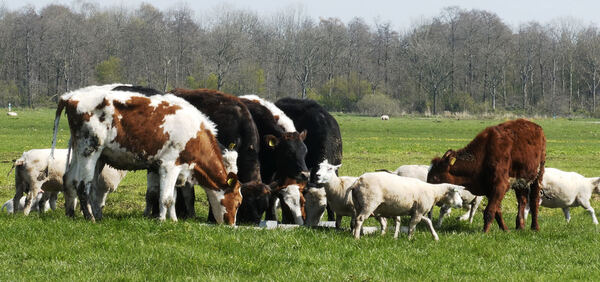Overgrazing is one of the most pressing environmental issues affecting ecosystems around the world. It occurs when herbivorous animals consume plant life faster than the land can regenerate, leading to soil degradation, loss of biodiversity, and long-term environmental harm. This article dives deep into the animals that contribute to overgrazing, its effects on ecosystems, and the best solutions to mitigate this problem.

Domestic Livestock
Wild Herbivores
Invasive Grazers
Soil Erosion
Loss of Vegetation
Biodiversity Decline
Climate Change Impact
Rotational Grazing
Grazing Management Techniques
Land Restoration
Overgrazing occurs when herbivores (animals that eat plants) consume more vegetation than an area can naturally regenerate. This typically happens when too many animals are allowed to graze in one area for too long, preventing the plants from growing back. Without plant life, the land begins to deteriorate, leading to soil erosion, loss of biodiversity, and desertification in some cases.
Overgrazing is not limited to agricultural areas—it also happens in wild ecosystems, where certain animal populations are left unchecked. This can have devastating effects on both the plants and animals that depend on these ecosystems.
Many animals, both domestic and wild, are involved in overgrazing. Here’s a breakdown of the main culprits:
Cattle, sheep, goats, and horses are the primary offenders in agricultural settings. These animals, when allowed to graze in large numbers for extended periods, can deplete the vegetation in a given area. For example, large herds of cattle on industrial farms often result in overgrazed pastureland. Without proper management, these livestock cause irreversible damage to soil and plant life.
Wild herbivores such as zebras, buffalo, deer, and Elephants-Are-Endangered.html">elephants also contribute to overgrazing. In protected environments like national parks, the absence of natural predators can cause the populations of these animals to grow excessively, leading to overgrazing. In regions like the savannas of Africa, Elephants-Are-Endangered.html">elephants and buffalo can strip entire areas of their vegetation, affecting plant diversity and soil quality.
Invasive species like rabbits, goats, and deer can be especially harmful when introduced into new ecosystems. These animals often have no natural predators in their new environments, so their numbers can explode. For example, in places like Australia and New Zealand, invasive species like European rabbits have caused severe environmental damage by overgrazing native vegetation.
Overgrazing has significant and far-reaching effects on both the land and the animals that depend on it. Here’s a closer look at the consequences:
When animals graze too much, they damage plant roots that help keep soil in place. Without these roots, the soil becomes loose and is more susceptible to erosion by wind and water. Over time, this erosion strips the land of its fertility, making it difficult for new plants to grow.
Overgrazing directly leads to the loss of vegetation. Plants are eaten before they have the chance to regenerate, which affects the entire ecosystem. Vegetation loss can lead to desertification, where once-productive land turns into barren desert.
As plants disappear, the animals that depend on them for food and shelter also begin to suffer. Insects, small mammals, and birds that rely on these plants for survival find it harder to thrive. Overgrazing disrupts the entire food chain, causing a loss of biodiversity.
Overgrazing can also contribute to climate change. Vegetation plays a vital role in absorbing carbon from the atmosphere. When overgrazing eliminates plant cover, less carbon is absorbed, leading to increased carbon levels in the atmosphere. Additionally, soil erosion contributes to the release of carbon stored in the soil, further exacerbating global warming.
Fortunately, there are several strategies to manage grazing and prevent overgrazing from damaging ecosystems. Let’s look at some of the most effective solutions:
Rotational grazing is one of the most effective ways to prevent overgrazing in agricultural settings. It involves moving livestock between different grazing areas, giving each area time to regenerate before animals return. This allows plants to recover and prevents the depletion of resources in any one area. Farmers can use fencing and grazing schedules to manage rotational grazing effectively.
Proper grazing management is essential for maintaining land health. This includes controlling the number of animals in a given area, regulating grazing duration, and using rest periods to allow vegetation to recover. Overgrazing can be avoided by ensuring that grazing is done responsibly and in accordance with land capacity.
In areas severely affected by overgrazing, land restoration techniques can help bring the ecosystem back to life. This can involve activities such as revegetation, erosion control, and soil health restoration. Additionally, reintroducing predators (where possible) to control herbivore populations can help restore balance to the ecosystem.
Overgrazing is a significant issue for both agriculture and wildlife ecosystems. It can result in soil degradation, loss of biodiversity, and long-term environmental damage. However, by implementing practices like rotational grazing, controlled grazing, and land restoration, we can mitigate the impacts of overgrazing and ensure that ecosystems continue to thrive.
The key to maintaining healthy ecosystems is finding a balance between grazing animals and the land they rely on. With proper management and a focus on sustainability, overgrazing can be prevented, and the land can continue to support both wildlife and agricultural activities for future generations.
animal tags: Overgrazing
We created this article in conjunction with AI technology, then made sure it was fact-checked and edited by a Animals Top editor.